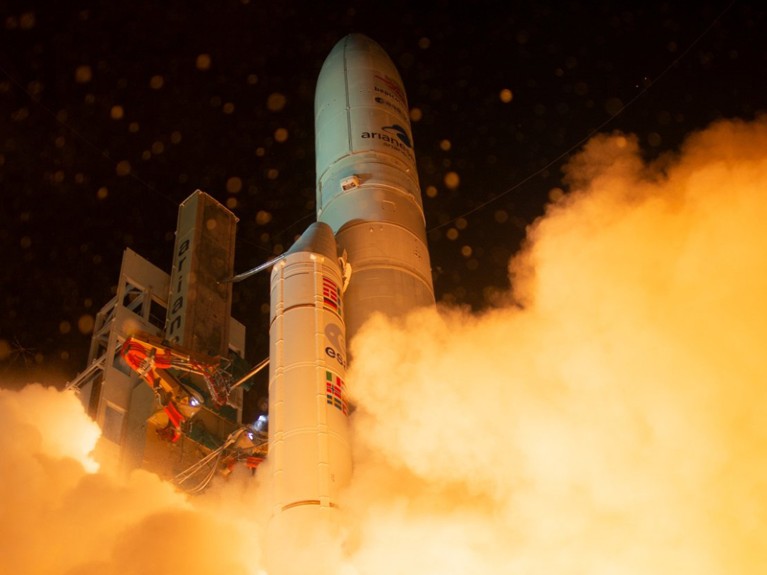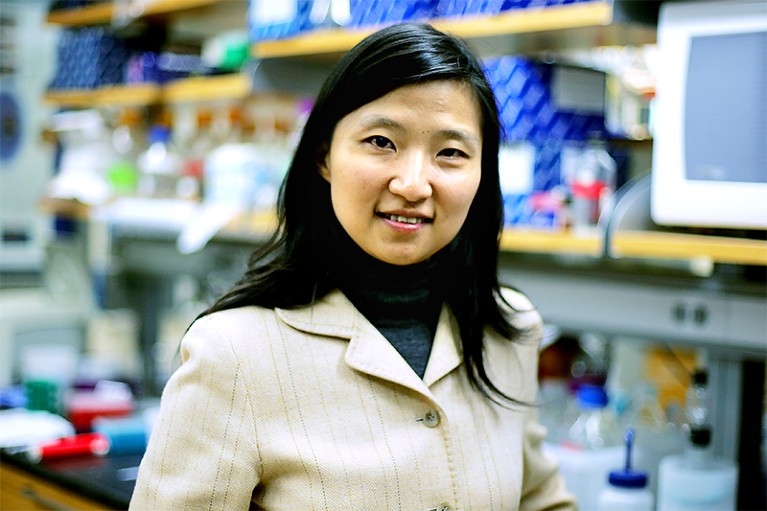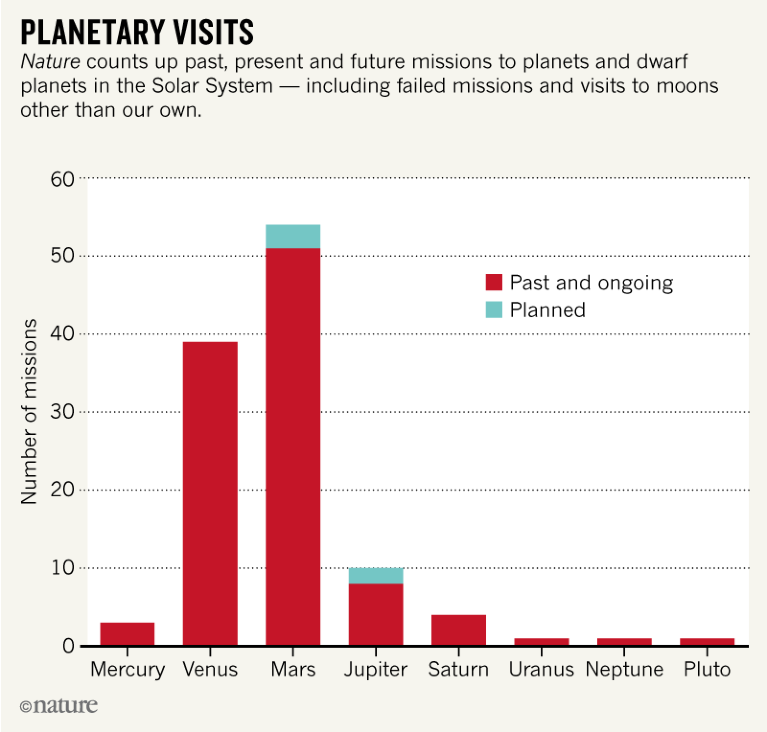EVENTS
BepiColombo heads off to Mercury A joint Japanese–European mission that is set to be the second ever to enter Mercury’s orbit launched successfully on 19 October from Kourou, French Guiana. The €1.6-billion (US$1.8-billion) mission, called BepiColombo, will insert two probes into the planet’s orbit in 2025, after several fly-bys of Earth, Venus and Mercury itself. One probe, built mainly by the European Space Agency (ESA), will study Mercury’s surface and its inner structure. The other, built by the Japan Aerospace Exploration Agency, will focus on the planet’s magnetic field and its interaction with the solar wind. Hours after launch, BepiColombo successfully deployed its antennas and two 15-metre-long “solar wings”, ESA said. The craft also took several “space selfies” using three on-board monitoring cameras.

The BepiColombo mission to Mercury launched from the European space port in Kourou, French Guiana, on 19 October.Credit: ESA/S.Corvaja
POLICY
NIH chimps Elderly and sick chimpanzees owned by the US National Institutes of Health (NIH) might spend their retirement at research facilities instead of a federal sanctuary if they are too frail to relocate, the agency said on 18 October. The NIH decided to retire all their chimps from research in 2015. Director Francis Collins says that the agency will develop guidelines to determine whether chimpanzees at facilities owned or supported by the NIH are well enough to move. The criteria will include assessments of each animal’s health, behavioural, social and environmental needs. If a research facility and the federal sanctuary — called Chimp Haven, in Keithville, Louisiana — cannot agree on whether an animal should be relocated, Collins says, the agency will have a panel of independent veterinarians inform the final decision.
Transparency rule The US Environmental Protection Agency (EPA) has delayed a decision on whether to implement a controversial rule that would limit the types of scientific research that can be used to justify environmental regulations. The proposed rule, unveiled in April by then-EPA administrator Scott Pruitt, would prevent the agency from basing regulatory decisions on studies whose underlying data are not publicly available — a requirement that could eliminate a lot of epidemiological and other health research. These studies often use confidential patient data that cannot be made public owing to privacy concerns. In a decision quietly released on 17 October, the agency delayed a final determination on the rule until at least 2020. The proposed rule faced criticism from researchers earlier this year, and the agency’s scientific advisory board voted to review the proposal in May.
Vaccine firm fined A Chinese pharmaceutical company caught producing faulty rabies vaccines has been fined billions of yuan by national and local agencies. China’s national drug regulator announced on 16 October that it will fine Changchun Changsheng Biotechnology 12 million yuan (US$1.7 million), and revoke the company’s licence to make rabies vaccines. The regulator determined that when the company created several batches of faulty rabies vaccine, it broke multiple laws, including: using expired products to make the vaccine; not testing the potency of vaccines according to prescribed methods; and destroying evidence to cover up its actions. The drug regulator of Jilin province, where the company’s headquarters are based, has issued the firm with a much larger fine: 7.21 billion yuan. The local regulator has revoked the company’s licence to produce pharmaceuticals and has banned 14 executives and others involved in the incident from engaging in drug production in the future. The company has not publicly responded to the penalties, but in a statement to its investors, the board said it would set up a group to handle compensation claims.
Brexit warnings World-leading scientists and mathematicians from across Europe have called on UK and European Union leaders to maintain the “closest possible cooperation” on science after Brexit, and have warned that any barriers to research collaboration in Europe will be to the detriment of all. The calls were made in a letter signed by 29 Nobel laureates and 6 recipients of the prestigious Fields medal for mathematics, and sent to UK Prime Minister Theresa May and European Commission president Jean-Claude Juncker on 19 October. They come as the United Kingdom approaches its March 2019 deadline for leaving the EU, and amid stalling negotiations on the country’s future relationship with the bloc. Brexit could see the end of Britain’s participation in EU research programmes — although UK leaders have indicated a desire to be part of future initiatives. The letter says that the United Kingdom must step up its commitment if it wants to stay involved.
AWARDS
Science mega-prize The inventor of a revolutionary, high-resolution microscopy technique was one of six big winners of this year’s Breakthrough prizes, announced on 17 October. The awards, each worth US$3 million, are given out annually in the life sciences, mathematics and fundamental physics. Xiaowei Zhuang (pictured), a biophysicist at Harvard University in Cambridge, Massachusetts, received one of the four life-sciences prizes for leading the development of stochastic optical-reconstruction microscopy — known as STORM — just over a decade ago. The technique was one of the first to break a fundamental resolution limit of conventional light microscopy, and is now used widely by biologists to reveal the hidden molecular structures of cells. Charles Kane and Eugene Mele at the University of Pennsylvania in Philadelphia won the fundamental-physics prize for their work predicting the existence of a type of exotic material known as a topological insulator. See go.nature.com/2nxevs1 for a full list of winners.

Xiaowei Zhuang has won a US$3-million Breakthrough prize in life sciences for her work on microscopy.Credit: Cheryl Senter/HHMI
PEOPLE
Physicist retires Lawrence Krauss will retire from his position as a professor at Arizona State University (ASU) in Tempe in May 2019. Earlier this year, the university began investigating allegations of sexual harassment against the physicist, allegations that Krauss denies. He has been on administrative leave since early March, following news reports of alleged harassment. The university accepted Krauss’s request to retire, an ASU spokesperson said on 21 October. Krauss founded and led ASU’s Origins Project on cosmic questions for nearly a decade; it is now being transformed into an Interplanetary Initiative to focus on the future of humans in space.
HEALTH
Ebola outbreak The World Health Organization (WHO) declared on 17 October that the Ebola virus outbreak in the northeast of the Democratic Republic of the Congo (DRC) — although extremely worrying — is not a ‘public health emergency of international concern’. The organization said that declaring the status would not significantly improve an already robust containment effort. The outbreak began in early August and is centred around the city of Beni. As of 21 October, there have been 203 confirmed cases and 35 probable cases — including 153 deaths. The outbreak is the tenth in the country’s history and has been complicated by armed conflicts in the region that are hampering containment efforts. The WHO noted the DRC’s long experience in handling Ebola episodes but said that ongoing vigilance is crucial.
Lassa fever Rats fuelled the largest outbreak of deadly Lassa fever in Nigeria this year, according to the most extensive and rapid genomic analysis of the Lassa virus conducted so far. The study, published on 17 October, eases fears that Lassa had mutated into a super-virus that was spreading swiftly between people (K .J. Siddle et al. N. Engl. J. Med. http://doi.org/gfdc4v; 2018). Instead, the viral genomes harvested from 220 patients were surprisingly diverse, indicating that most people had not acquired their infections from someone else. The unprecedented speed of this analysis has helped officials to combat the spread of Lassa fever, and the virus’s genetic information will assist researchers as they develop vaccines against the illness. About 514 people fell ill with the disease between January and September, and 134 of them have died.
TREND WATCH
The BepiColombo probe, launched on 19 October, will be only the third mission to approach Mercury. Meanwhile, NASA is planning the landing site for its next rover to Mars, a planet that has been targeted around 50 times. So which of our Solar System’s planets proved most popular with space scientists — and why? Since planetary missions began in the 1960s, each planet has had at least a flying visit from a spacecraft — but the vast bulk of attention has been focused on just a few. Mars and Venus top the list, partly owing to their proximity and to interest in their past conditions — water on Mars and Venus’s previously more Earth-like climate. Mercury has been neglected among the inner planets because it is challenging to reach. Its proximity to the Sun means that craft need to slow down considerably before they enter the planet’s orbit. Visiting Uranus, Neptune and the dwarf planet Pluto is also technically challenging, but some astrophysicists say that to truly understand the Solar System, humans will need to step up exploration of these bodies and their moons. Scientists are also planning to send two orbiters to Jupiter’s moons.

Source: NASA



